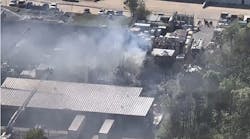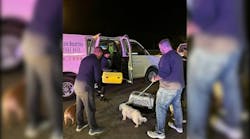The Electronic Fireground Accountability System (EFAS) was rolled out for several companies six months ago and Chief of Safety Stephen Raynis said he expects the program to expand during the course of the year.
"We need to know where our guys are if they get in trouble," he said.
Raynis spoke to attendees at FDIC in Indianapolis on Wednesday about the advances made by the FDNY since 9/11.
He said the EFAS system built by the department's research and development team is "revolutionary."
Currently when a firefighter signals a Mayday through a handheld radio, their ID number is transmitted but once another transmission is made, that ID is cleared out, leading to confusion as to which firefighter sounded the alert.
The new system uses the existing radios and sends information through software to a device controlled by the incident commander.
The program contains detailed information for each firefighter and when a Mayday is made, their name becomes highlighted among the list of names.
Raynis said the EFAS is just one thing the FDNY has done to help change the safety culture of the department since 9/11.
"It's important to remember where we were on 9/11 and where we are now. We were able to get up, brush ourselves off and become a stronger, safer fire department."
Following that tragic day, the department reexamined itself and put into motion initiatives that could help enhance the safety of its firefighters.
Raynis said instituting those changes, however, had just as much to do with the attitude of the firefighters as it did with the training they were given.
"No safety program will work unless the membership buys in," he said.
The department instituted an injury reduction program in which officers visit each firehouse and show firefighters videos and photographs of near-miss calls from which they can learn.
While some firefighters may have been resistant to the concept at first, Raynis said they eventually bought into the program.
"It's company officers talking to firefighters. It's not a chief going in there," he said. "It's down to their level."
Visits were made to every firehouse four times to reach all shifts and after a successful run, an accident reduction program was launched.
"Every fire we go to we have mistakes, we're all human," Raynis said. "We need to get rid of those little mistakes and address them before they become big ones."
A move he said wasn't as easy of a sell was the decision to limit the use of lights and sirens during some responses.
For non-emergency calls in which only one unit is dispatched, lights and sirens are not activated.
During higher-level calls including automatic alarms, electrical emergencies and some manhole fires, the first ladder and engine sent respond in emergency mode while the others do not.
The department hopes this decision is eventually accepted and helps cut down on both apparatus collisions and fatalities resulting from those incidents
Other programs the departments is working on include an Electronic Command Board, which will compliment the EFAS, improved seat belt systems which are currently being installed and a safety kiosk to provide firefighters with information -- set to debut in a Staten Island firehouse on May 1.





